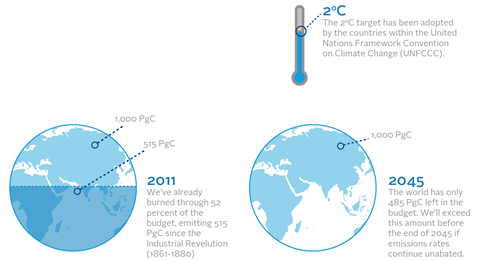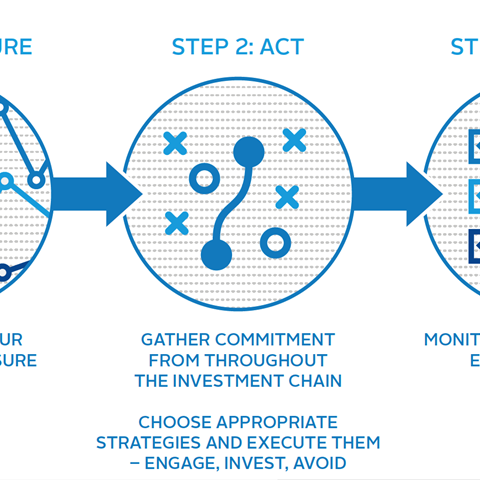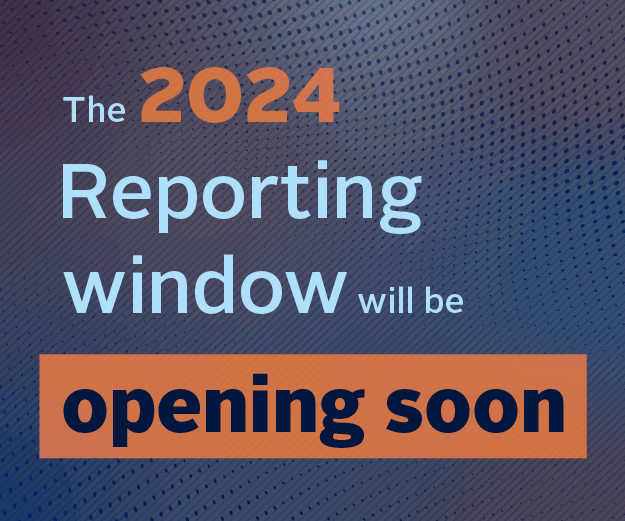There is global scientific consensus on the world’s carbon budget of 1 trillion tonnes of carbon. This is the amount of carbon dioxide the world can emit while having a likely chance of averting the most dangerous climate change impacts. Analysis from the IEA and PwC show a need for the global economy to reduce its carbon intensity as much as five times faster than is currently the case. There is a growing imperative for asset owners to align their investment portfolios with a low-carbon economy.
Portfolio risks and opportunities
Climate change presents significant risks to asset owners, as well as opportunities for those exposed to companies that are likely to prosper in a lower carbon world. A 2015 Mercer report found that asset owners with diversified, long-term portfolios will be exposed to costs associated with climate change and that investment returns are likely to be impacted. A 2015 report from The Economist finds the value at risk to manageable assets from climate change is US$4.2 trillion. Private-sector discount rates show that 6°C of warming could lose US$13.8 trillion of present value.
These profound economic shifts also offer significant opportunities for investors in areas such as clean energy, energy efficiency and new technologies7. At the same time, asset owners can also engage with public policy makers to help make the transition as smooth as possible for the financial markets.
Fiduciary duty
Fiduciary duty in the 21st century, a joint PRI, UNEP FI, UNEP Inquiry and UN Global Compact report, finds that managing material environmental, social and governance (ESG) risks is consistent with investors’ fiduciary duty.
”Fiduciaries need to be able to show that they have identified and assessed the risks (to companies and to their portfolios). In the case of climate change, for example, this would require them to:
- show that they have recognised relevant risks (even if they are sceptics on the issue of climate change);
- analyse how climate change might affect investment returns over the short, medium and long-term;
- explicitly manage the risks, and not assume that the risks are automatically managed by other risk management strategies;
- interrogate and challenge the individuals or organisations (e.g. investment managers, companies) to ensure that these risks are being effectively managed;
- establish processes that enable them to demonstrate the actions they have taken.”
Fiduciary duty in the 21st century
Universal ownership
Large asset owners, particularly passive investors, are the “permanent and universal owners” of companies, with links to the overall economy. Such asset owners have a financial interest in the well-being of the economy as a whole: they invest in a small share of the whole global economy through highly-diversified portfolios, with more or less long time horizons. By exercising ownership rights, through engagement with companies and policy makers, universal owners can encourage protection of the environment, economy and long-term investment returns.
What is the carbon budget?
The carbon budget is the estimated amount of carbon dioxide the world can emit while still having a likely chance of limiting global temperature rise to 2oC above pre-industrial levels. The international scienti c community estimates this budget to be 1 trillion tonnes of carbon (1,000 PgC).

Three steps to develop a climate change strategy
This framework focuses on investment actions to mitigate climate change – how actions by asset owners can reduce their exposure to climate change risk in their investment portfolios and also support the reduction of emissions in the real economy.
For further guidance on how to set a climate change investment strategy, including review at Board and trustee level, mitigation investment actions and adaptation investment actions, see the Global Investor Coalition on Climate Change’s 2015 report Climate Change Investment Solutions: A Guide for Asset Owners.
To tailor the steps below to their own needs, asset owners should select suitable strategies from the framework below and adapt them to fit their own motivations, objectives and investment approaches. Strategies will likely differ based on at least asset owner type (corporate/public pension funds, university endowments, charitable foundations or others), active/passive management and responsible investment maturity level.
Downloads
Developing an asset owner climate change strategy
PDF, Size 1.11 mb
Developing an asset owner climate change strategy
- 1
Currently reading
The case for action
- 2
- 3
- 4
- 5
- 6
- 7


















